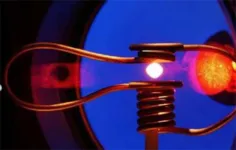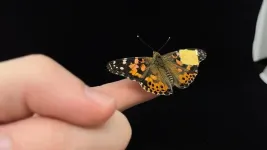(Press-News.org) Federal reservoirs could help meet the country’s solar energy needs, according to a new study published in Solar Energy.
For the study, Evan Rosenlieb and Marie Rivers, geospatial scientists at the U.S. Department of Energy National Renewable Energy Laboratory (NREL), as well as Aaron Levine, a senior legal and regulatory analyst at NREL, quantified for the first time exactly how much energy could be generated from floating solar panel projects installed on federally owned or regulated reservoirs. (Developers can find specific details for each reservoir on the website AquaPV.)
And the potential is surprisingly large: Reservoirs could host enough floating solar panels to generate up to 1,476 terawatt hours, or enough energy to power approximately 100 million homes a year.
“That’s a technical potential,” Rosenlieb said, meaning the maximum amount of energy that could be generated if each reservoir held as many floating solar panels as possible. “We know we’re not going to be able to develop all of this. But even if you could develop 10% of what we identified, that would go a long way.”
Levine and Rosenlieb have yet to consider how human and wildlife activities might impact floating solar energy development on specific reservoirs. But they plan to address this limitation in future work.
This study provides far more accurate data on floating solar power’s potential in the United States. And that accuracy could help developers more easily plan projects on U.S. reservoirs and help researchers better assess how these technologies fit into the country’s broader energy goals.
Floating solar panels, also known as floating PV, come with many benefits: Not only do these buoyed power plants generate electricity, but they do so without competing for limited land. They also shade and cool bodies of water, which helps prevent evaporation and conserves valuable water supplies.
“But we haven’t seen any large-scale installations, like at a large reservoir,” Levine said. “In the United States, we don't have a single project over 10 megawatts.”
Previous studies have tried to quantify how much energy the country could generate from floating solar panels. But Levine and Rosenlieb are the first to consider which water sources have the right conditions to support these kinds of power plants.
In some reservoirs, for example, shipping traffic causes wakes that could damage the mooring lines or impact the float infrastructure. Others get too cold, are too shallow, or have sloping bottoms that are too steep to secure solar panels in place.
And yet, some hydropower reservoirs could be ideal locations for floating solar power plants. A hybrid energy system that relies on both solar energy and hydropower could provide more reliable and resilient energy to the power grid. If, for example, a drought depletes a hydropower facility’s reservoir, solar panels could generate energy while the facility pauses to allow the water to replenish.
And, to build new pumped storage hydropower projects—which pump water from one reservoir to another at a higher elevation to store and generate energy as needed—some developers create entirely new bodies of water. These new reservoirs are disconnected from naturally flowing rivers, and no human or animal depends on them for recreation, habitat, or food (at least not yet).
In the future, the researchers plan to review which locations are close to transmission lines or electricity demand, how much development might cost at specific sites, whether a site should be avoided to protect the local environment, and how developers can navigate state and federal regulations. The team would also like to evaluate even more potential locations, including other, smaller reservoirs, estuaries, and even ocean sites.
The research was funded by the Solar Energy Technologies Office and the Water Power Technologies Office in DOE’s Office of Energy Efficiency and Renewable Energy (EERE).
Access the study to learn more about the immense potential for floating solar plants in the United States, or visit AquaPV to dig into the data on specific reservoirs.
NREL is the U.S. Department of Energy's primary national laboratory for renewable energy and energy efficiency research and development. NREL is operated for DOE by the Alliance for Sustainable Energy LLC.
END
Floating solar panels could support US energy goals
New study shows federally controlled reservoirs could host enough energy to power approximately 100 million US homes a year
2025-01-14
ELSE PRESS RELEASES FROM THIS DATE:
Long before the L.A. fires, America’s housing crisis displaced millions
2025-01-14
A new USC study reveals that the challenges that led to a national shortage of affordable housing and soaring home prices were set in motion long ago — and could have been foreseen.
The researchers behind the study say that the problem will only worsen as more natural disasters — such as the devastating Los Angeles area wildfires and large hurricanes — flatten entire communities. Los Angeles County officials estimate that more than 10,000 homes and businesses have been lost so far to the fires that erupted across the region last week.
“A ...
Breaking barriers: Collaborative research studies binge eating disorders in older Hispanic women
2025-01-14
SAN ANTONIO, Jan. 14, 2025 – Scientists from The University of Texas Health Science Center at San Antonio (UT Health San Antonio) and Trinity University are partnering with the San Antonio Food Bank for a four-year, $2.2 million study on eating disorders in older Hispanic women.
A grant from the National Institute on Aging of the National Institutes of Health is funding this transformative study, which aims to redefine how the intersection of binge eating, food insecurity and health disparities among ...
UVA receives DURIP grant for cutting-edge ceramic research system
2025-01-14
The University of Virginia School of Engineering and Applied Science is set to revolutionize materials science with the development of a state-of-the-art electromagnetic levitation (EML) system, funded by a competitive Defense University Research Instrumentation Program (DURIP) grant. Designed to operate in extreme conditions, the system enables researchers to study ultra-high-temperature ceramics (UHTCs) in their solid and molten states — unlocking new possibilities for aerospace, defense and industrial applications.
Rethinking High-Temperature Research
Traditional methods of studying UHTCs are limited by the challenges of chemical contamination at extreme temperatures. The EML system’s ...
Gene editing extends lifespan in mouse model of prion disease
2025-01-14
Researchers at the Broad Institute of MIT and Harvard have developed a gene-editing treatment for prion disease that extends lifespan by about 50 percent in a mouse model of the fatal neurodegenerative condition. The treatment, which uses base editing to make a single-letter change in DNA, reduced levels of the disease-causing prion protein in the brain by as much as 60 percent.
There is currently no cure for prion disease, and the new approach could be an important step towards treatments that prevent the disease or ...
Putting a lid on excess cholesterol to halt bladder cancer cell growth
2025-01-14
LA JOLLA (January 14, 2025)—Like all cancers, bladder cancer develops when abnormal cells start to multiply out of control. But what if we could put a lid on their growth?
Previous studies showed that a protein called PIN1 helps cancers initiate and progress, but its exact role in tumor development has remained unclear. Now, cancer biologists at the Salk Institute have discovered that PIN1 is a significant driver of bladder cancer and revealed that it works by triggering the synthesis of cholesterol—a membrane lipid essential for cancer cells to grow.
After mapping out the molecular pathway between PIN1 and ...
Genetic mutation linked to higher SARS-CoV-2 risk
2025-01-14
RIVERSIDE, Calif. -- Researchers have identified a novel genetic risk factor for SARS-CoV-2 infection, providing new insights into the virus’ ability to invade human cells. SARS-CoV-2 is the virus that spreads COVID-19.
The study, led by immunologist Declan McCole at the University of California, Riverside, shows that a loss-of-function variant in the phosphatase gene PTPN2, commonly associated with autoimmune diseases, can increase expression of the SARS-CoV-2 receptor ACE2, making cells more susceptible to viral invasion.
A loss-of-function ...
UC Irvine, Columbia University researchers invent soft, bioelectronic sensor implant
2025-01-14
Irvine, Calif., Jan. 14, 2025 — Researchers at the University of California, Irvine and New York’s Columbia University have embedded transistors in a soft, conformable material to create a biocompatible sensor implant that monitors neurological functions through successive phases of a patient’s development.
In a paper published recently in Nature Communications, the UC Irvine scientists describe their construction of complementary, internal, ion-gated, organic electrochemical transistors that are more amenable ...
Harnessing nature to defend soybean roots
2025-01-14
The microscopic soybean cyst nematode (SCN) may be small, but it has a massive impact. This pest latches onto soybean roots, feeding on their nutrients and leaving a trail of destruction that costs farmers billions in yield losses each year. Unfortunately, current methods to combat SCN are faltering as the pest grows resistant to traditional controls. But new research is now offering a glimmer of hope.
A collaborative team of scientists from BASF Agricultural Solutions and the Advanced Bioimaging Laboratory at the Donald Danforth Plant Science Center are working on a potential solution: ...
Yes, college students gain holiday weight too—but in the form of muscle not fat
2025-01-14
With the holidays behind us, many Americans are seeing the numbers on the scale go up a pound or two. In fact, data shows that many American midlife and older adults gain 1 to 1.5 pounds over the November through January holiday period. Though not harmful on its own, even a small amount of holiday weight gain in the form of fat can negatively affect health. People often fail to lose the extra weight, which leads to significant cumulative weight gain over the years and contributes to health concerns.
Based on new research, we now know that college students gain the same amount of weight as older ...
Beach guardians: How hidden microbes protect coastal waters in a changing climate
2025-01-14
A hidden world teeming with life lies below beach sands. New Stanford-led research sheds light on how microbial communities in coastal groundwater respond to infiltrating seawater. The study, published Dec. 22 in Environmental Microbiology, reveals the diversity of microbial life inhabiting these critical ecosystems and what might happen if they are inundated by rising seas.
“Beaches can act as a filter between land and sea, processing groundwater and associated chemicals before they reach the ocean,” said study co-first author Jessica Bullington, a Ph.D. student in Earth system science in the Stanford Doerr School of Sustainability. “Understanding ...
LAST 30 PRESS RELEASES:
How human interaction drove evolution to make bears less aggressive
National Poll: Few parents offer teens guidance on healthy eating during holiday season
Cannabis derivatives could provide new ovarian cancer treatments
Raising strong yeast as a petroleum substitute
Clues to the origin of hot Jupiters hidden in their orbits
Canada’s reduced pledge to Global Fund will impact domestic health
1 in 4 children with major traumatic injuries not cared for in pediatric trauma centres
Duke and Duke-NUS’ joint cross-population research to uncover "East-West" differences in disease and care
Scientists to ‘spy’ on cancer- immune cell interactions using quantum technology breakthrough
Tech savvy users have most digital concerns
Making lighter work of calculating fluid and heat flow
Normalizing blood sugar can halve heart attack risk
Lowering blood sugar cuts heart attack risk in people with prediabetes
Study links genetic variants to risk of blinding eye disease in premature infants
Non-opioid ‘pain sponge’ therapy halts cartilage degeneration and relieves chronic pain
AI can pick up cultural values by mimicking how kids learn
China’s ecological redlines offer fast track to 30 x 30 global conservation goal
Invisible indoor threats: emerging household contaminants and their growing risks to human health
Adding antibody treatment to chemo boosts outcomes for children with rare cancer
Germline pathogenic variants among women without a history of breast cancer
Tanning beds triple melanoma risk, potentially causing broad DNA damage
Unique bond identified as key to viral infection speed
Indoor tanning makes youthful skin much older on a genetic level
Mouse model sheds new light on the causes and potential solutions to human GI problems linked to muscular dystrophy
The Journal of Nuclear Medicine ahead-of-print tip sheet: December 12, 2025
Smarter tools for peering into the microscopic world
Applications open for funding to conduct research in the Kinsey Institute archives
Global measure underestimates the severity of food insecurity
Child survivors of critical illness are missing out on timely follow up care
Risk-based vs annual breast cancer screening / the WISDOM randomized clinical trial
[Press-News.org] Floating solar panels could support US energy goalsNew study shows federally controlled reservoirs could host enough energy to power approximately 100 million US homes a year




